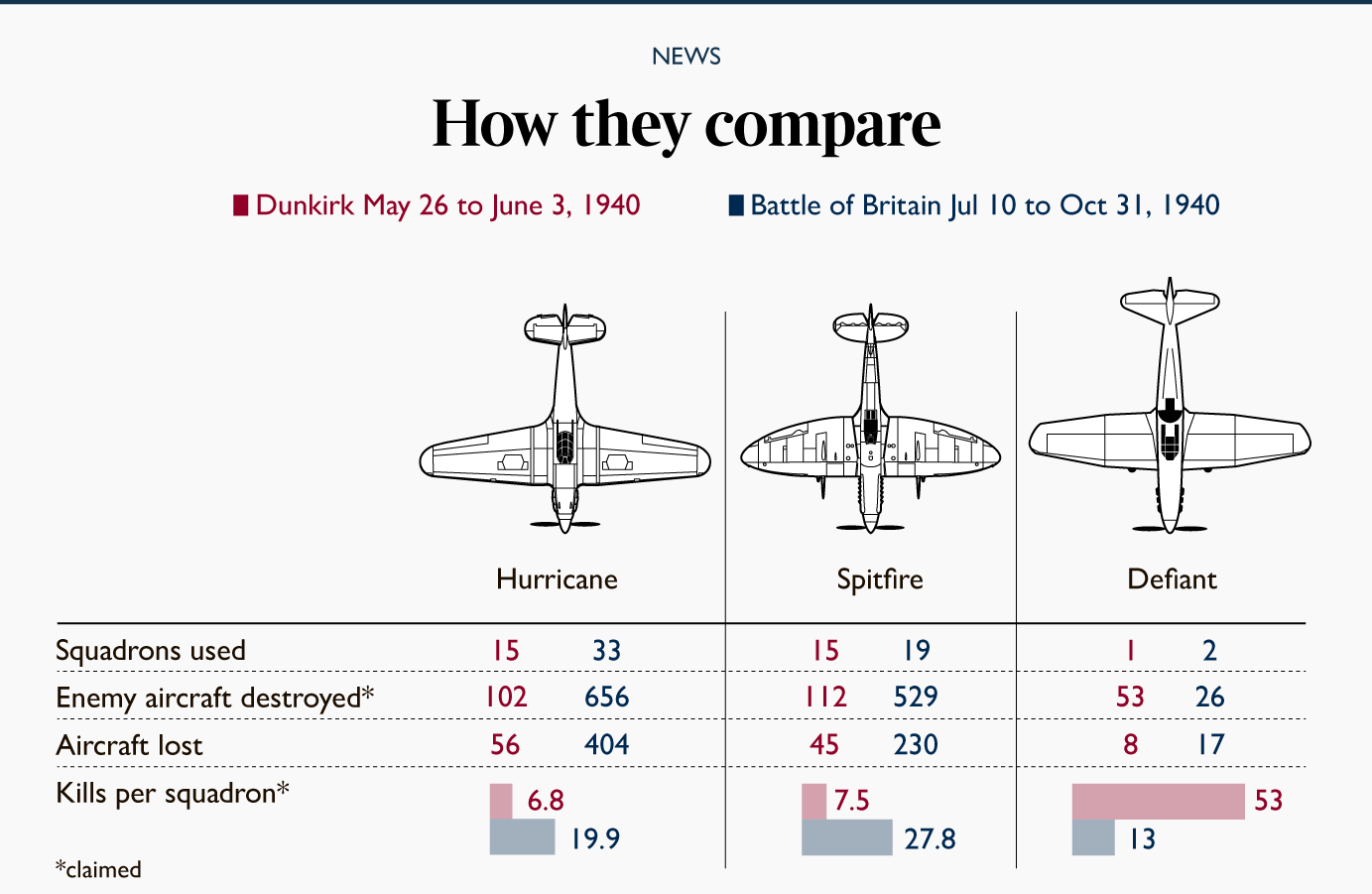https://www.thetimes.co.uk/article/i...iant-x8wvxcmkg
In defence of the ‘feeble’ Defiant
It was described as a “peculiar” aircraft by its own crews and derided by German aces as a feeble kill compared with a Hurricane, let alone a Spitfire. Now an author has claimed that the Boulton Paul Defiant was more deadly than its reputation suggests, and that the
Battle of Britaincould have been an even greater victory if the aircraft had been given a fair chance.
The Defiant is remembered, if at all, as a design failure. Resembling the Hawker Hurricane with the addition of a gun turret behind the cockpit, it was intended to approach underneath or alongside bombers, where the gunner could devote his full attention to raking them with rounds from four .303in Browning machineguns. The design was conceived in the mid-1930s when Air Ministry officials anticipated having to defend Britain against large unescorted formations of enemy bombers. To ensure that pilots focused on getting their gunner into the best position, and for reasons of weight, it had no fixed forward-facing guns.
Its early champions included Winston Churchill, who predicted in 1938 that the turret fighter design would be “paramount” in any conflict. However, after heavy losses in the Battle of Britain, it has often been viewed as an unmitigated death trap.
In
Defiant: The Untold Story of the Battle of Britain, Robert Verkaik argues that standard accounts have underplayed the heroism and successes of the aircraft’s two-man crews and disregarded leadership decisions influencing its later underperformance. He said perhaps the greatest omission was the “awkward” fact that a Defiant squadron still holds the record for shooting down the most enemy aircraft in one day.
This was on May 29, 1940, when the Luftwaffe mounted five large attacks on ships evacuating soldiers from the beaches of
Dunkirk. The German planes were met by two successive RAF patrols of four fighter squadrons, including 264 Squadron, a Defiant squadron commanded by Philip Hunter. On each patrol the Defiants and one squadron of Hurricanes or Spitfires, were tasked with downing the enemy bombers while other Hurricanes flew above to take on fighters.
Nevertheless, during the first sortie six Messerschmitt Me 109 fighters broke away from the Hurricanes that had engaged them and swept on to the Defiants’ tails from out of the sun. Rather than picking off the slower aircraft, the Germans found themselves hurtling into a hail of lead and tracer. The Defiants’ gunners continued to hammer away as the Me 109s were followed by 22 Messerschmitt Me 110 heavy fighters. By the end of the sortie, 264 Squadron had claimed two Me 109s, 15 Me 110s and a Junkers Ju 87 “Stuka” dive bomber, without losing a single aircraft.
And they weren’t done. In the second patrol that afternoon they caught a force of Stukas and Junkers Ju 88s bombing ships. While Hurricanes tackled German fighters above, the Defiants found that the Stukas were “easy meat”, Eric Barwell, a pilot, recalled.
In total that day the squadron claimed 38 enemy aircraft were destroyed. This remains a record, and, although it was likely to be an overestimate, Verkaik said it gave Britons a sorely needed morale boost. Flight Lieutenant Nicholas Cooke and his gunner Acting Corporal Albert Lippett had five kills, making them the first RAF “aces in one day” of the Second World War.
Two days later, the Defiants were involved in the RAF’s heaviest fighting of the Dunkirk campaign, claiming four Me 109s and five Heinkel He 111s. It came at a heavy price of five Defiants lost and five airmen dead, including Cooke and Lippett.

Verkaik writes: “There is little doubt that the two patrols involving the Defiants, which met the full force of the Luftwaffe attacks, blunted the enemy’s strikes against the Royal Navy ships which had been targeted by more than 300 enemy aircraft. That day the navy lost just two ships [minesweepers] while evacuating nearly 68,000 men from the Dunkirk beaches — the greatest number in a single day during Operation Dynamo.”
From May 12 to 31, when 264 Squadron served on the front line in the lead up to and during the Dunkirk evacuation, its Defiants shot down 65 enemy aircraft, more than any other RAF squadron.
This pre-eminence was not to last, however. On July 19, early in the Battle of Britain, Defiants of 141 Squadron at Hawkinge in Kent were scrambled to intercept German raiders. The aircraft, none of whose pilots had combat experience, were sent without fighter cover. As Verkaik recounts, they were “caught napping” by two
Staffels of Me 109s, which swooped from above and behind to pick off six out of nine aircraft as airmen watched horrified from the ground.
Philip Hunter, whose 264 Squadron had performed so well at Dunkirk, was killed the next month when his squadron was sent to Manston airfield in Kent as part of the first line of defence.
Some people have argued that if the commanders Hugh Dowding and Keith Park had not resisted the Air Ministry’s ambition of equipping one third of Fighter Command with Defiant squadrons the RAF would have lost the Battle of Britain.
On the contrary, Verkaik believes that with proper fighter protection, the Defiant would have acquitted itself well and the Luftwaffe might have lost more bombers more quickly than it did. Instead he said it was “miscast” as an independent fighter, rather than a bomber destroyer operating in tandem with Hurricanes and Spitfires. He disagrees with claims that its early successes were only down to hapless German pilots mistaking it for the Hurricane and running into its guns.
Even during the Battle of Britain, the performance of the relatively small number of Defiants took a toll on the Luftwaffe. In the ten days to August 28, 264 Squadron claimed 19 kills, albeit with a loss of 11 aircraft and 13 air crew.
After the battle, the Defiant served as the most successful RAF night fighter during the Blitz before it was retired from frontline combat service after 1942.......